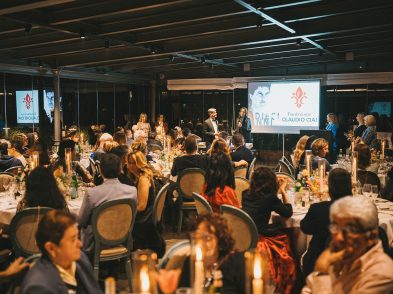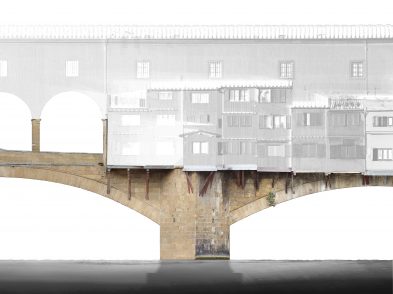Trained at Harvard, professor Rab Hatfield taught at Yale for five years before coming to Florence to head the Art History Department at Syracuse University. The majority of his research deals with Renaissance art, with a particular emphasis on Michelangelo and Leonardo da Vinci. His books include The Riches of Michelangelo: How a Great Artist Deceived the Papacy and Botticelli’s Uffizi ‘Adoration’: A Study in Pictorial Content (in the Princeton Essays on the Arts series). His current research focuses on locating the famed battle mural by Leonardo da Vinci, which is said to grace the Salone dei Cinquecento in Palazzo Vecchio. According to Hatfield, The Battle of Anghiari is situated under the fresco later painted by Giorgio Vasari (1571–1572)
Where exactly is Leonardo’s missing masterpiece located?
Beyond the shadow of a doubt it’s in the Salone dei Cinquecento’s Palazzo Vecchio. It’s probable that Vasari was staring straight at the painting until he built a wall in front of it. He left no direct mention of it, which I find very strange. Nonetheless, I do believe he was familiar with the piece. I say this because in the frescoes Vasari painted in that hall, there are obvious references to Leonardo’s battle scene.
So, in reality scholars have a very good idea as to where it is?
We know that Leonardo’s painting takes its light from the right, which is quite unusual; this would suggest that it’s located on the right-hand side of the wall. Furthermore, we know that the Signoria built some passage ways so that they could safely get to their seats when the Great Council was in session. Historical records show that an aisle passed in front of the area occupied by the advisory body. So, in order to find the painting, it’s just a question of calculating how much space the Signoria needed. It’s up there somewhere—a couple meters one way or the other.
What have you learned about the painting from your research?
I’ve been able to discover how big the painting actually was. In 1512, the Medici came in and established what they called a Palace Guard—it was actually a small army— and housed the soldiers right there in the Salone dei Cinquecento. In order to protect the painting, the Medici bought boards to presumably board up the masterpiece or put a crate around it. And they recorded the square area of these boards. They used their system of measurement obviously, but we’re talking about the equivalent of 15 square meters. That measurement is probably a little bit bigger than the painting itself—we can guess that it stretched about12 meters. That’s still a pretty big painting! Even if we are off by two or three meters, we’ve still got a good chance of hitting it on the first try if its still there. And that’s something that nobody can really say at this point. We think the painting was already deteriorating during Vasari’s time, but we also know that a good friend of Michelangelo’s wrote to a friend in Venice saying that one of the things he had to see in Florence were ‘the horses of Leonardo’.
What exactly does the masterpiece represent?
It’s very simple: it depicts the capture of a standard by a couple of Florentine troops. According to one of the most authoritative historical accounts of the Battle of Anghiari, the thing that finally tipped the battle was the capture of an enemy standard. Just before da Vinci started painting, Florence won another one of its most famous battles ever. The Florentines captured 13 standards on that occasion and hung them in the Hall two days later. Probably that’s why Leonardo decided to paint that subject.
Does Vasari say why he covered up a painting that he considered one of the most important pieces of the time?
He doesn’t have to. Vasari was working for the Duke, who had absolute power. The Duke wanted that room turned into a type of throne room, and he commissioned it to be beautifully and expensively decorated. There’s just no way you can hang on to the beginning of a painting—great though it may be—especially if it was probably already starting to disintegrate anyway.
So we have no idea what state it’s in?
No, but from the time Vasari put that diaphragm in front of it, the painting’s been very well protected. We have another example of Vasari using the same technique to keep other masterpieces from being harmed. He covered a great masterpiece by Masaccio in Santa Maria Novella, for example, by putting a great big stone frame in front of it, leaving space between the frame and the painting. In the nineteenth century they decided that they didn’t approve of Renaissance frames in a Gothic church, so they took the frames out and discovered the original Masaccio.
Why do you think authorities haven’t made efforts to see if the painting’s still there?
It’s partly a jurisdiction problem. The Palazzo Vecchio and everything in it belongs to the city of Florence. Then there’s the Sopraintendenza, which is a national branch of government. I believe it has the power to override the city wherever major monuments are involved. But still, the painting is the property of Florence, not the state of Italy. It sounds as if there’s a power struggle and perhaps conflicting personalities are involved. But, contrary to popular belief, it’s not a question of looking at the thing with infrared—all we’d need to do is drill a little hole or probably a number of little holes and go in with an endoscope. We’re assuming that there’s a little bit of space between the Vasari wall and the original surface. This reasoning is based on testing done by Maurizio Seracini and is proven by the fact that the wall is so beautifully smooth. One can guess that the original wall was pretty lumpy. So, probably there’s some air in there.
Do you think the painting will ever be discovered?
If its there, someone’s going to find it eventually. It’s just a question of when. It would be a wonderful thing for this city. It would be a wonderful for the person who makes this discovery. Someday, someone’s going to come along and think ‘Hey, I can be famous’, and will take a look. Right now, I’m preparing a completely scholarly article that’s meant to serve as total proof. Once it’s published, I’ll start taking my research to people and say, ‘I think this proves that Leonardo painted his masterpiece in this position’. The real goal of the project is to find out whether or not the painting has survived. There is only one way to find out—and that is to look!







